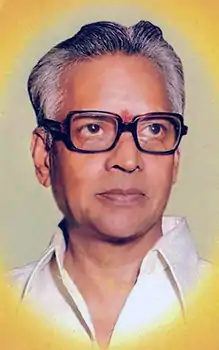S. Rajeswara Rao
Saluri Rajeswara Rao (11 October 1922 – 25 October 1999) was an Indian composer, multi instrumentalist, conductor singer-songwriter, actor, music producer, and musician known for his works predominantly in South Indian cinema.[1] Regarded as one of the finest music composers, Rao's works are noted for integrating Indian classical music in Telugu cinema for over half a century.[2]
S. Rajeswara Rao | |
|---|---|
 | |
| Background information | |
| Also known as | Saluri Rajeswara Rao |
| Born | 11 October 1922 Sivaramapuram, Andhra Pradesh, India |
| Origin | Sivaramapuram, Vizianagaram district, Andhra Pradesh, India |
| Died | 26 October 1999 (aged 77) |
| Genres | Indian film scores |
| Occupation(s) | Composer |
| Instruments | Harmonium Tabla Dholak Mrudangam Flute Electric Guitar Piano Violin |
| Years active | 1934–1986 |
In his recordings, Rao pioneered the use of light music in Telugu cinema; "Thummeda Oka saari", "Kopamela Radha", "Podarintilona", "Rave Rave Koyila", "Challa Gaalilo" and "Paata Paduma Krishna" were all written by his father. Rao's most rewarding assignments came from Gemini Studios, which he joined in 1940 and with which he remained for a decade.[3]
After leaving Gemini, he received an offer to provide music for B. N. Reddy's "Malleeswari" in 1950; the song was a hit. "Vipranarayana", "Missamma" and a host of other musical hits – more than a hundred in Telugu most of which won the National Film Awards for best film(s), and Tamil and a few in Kannada – followed. When Vijaya's Missamma (originally a Telugu film) was remade as Miss Mary in Bollywood, the film's soundtrack retained one of Rao's compositions.[1]
Early career
Rao's introduction to cinema came unexpectedly, in the form of Mr. Huchins' (of the Huchins Recording Company) visit to Rao's home district of Vizianagaram in 1934. A child prodigy, Rao could identify the Carnatic music ragams at age four; by the time he was seven, he was giving stage performances. Huchins spotted young Rajeswara Rao's talent, and took him to Bangalore with his father; there, young Rao recorded "Bhagawat Gita". Film producers P. V. Das and Gudavalli Ramabramham visited Bangalore and, impressed by Rao's singing ability, brought him to Madras. They cast him as Lord Krishna in their production of Sri Krishna Leelalu in 1934. The film was released the next year (1935) and Rajeshwara Rao became a household name all over Andhra Pradesh.
Rao went to Calcutta (now Kolkata) to act in Keechaka Vadha, and met such stalwarts as Kundan Lal Saigal and Pankaj Mullick.[3] He became a disciple of Saigal and studied Hindustani music for a year, learning to play the sitar and surbahar. Rao had already mastered playing the tabla, dholak, and miridangam; later instruments were piano, harmonium, mandolin and electric guitar. He learned orchestration, and how to mix the sounds of different instruments.
Music director
Returning to Madras in 1938, Rao formed his own music troupe. He worked as assistant to Jayaramayyar for a Tamil film, Vishnuleela, in which he also played the role of Balarama and sang his own songs. He became a full-fledged music director on the film Jayaprada. He continued acting in Bala Nagamma and Illalu (in which he played opposite his singing partner, Raavu Balasaraswathi).
When Rao entered the industry, there was no playback system. The actors sang and acted at the same time as the orchestra played in the background, unseen by the camera. While he was making Illalu, the playback system became popular.[1]
Among the classical ragas, Rao liked "Bhimplas (Abheri)", "Sindhu Bhairavi", "Kafi", "Kalyani", "Pahad" and "Malkauns (Hindolam)", which he used most frequently in his songs. His two assistants (for over four decades), Rajagopal and Krishnan – both well-versed in classical music – were an asset to him.
Personal life
Rao was born in the village of Sivaramapuram, near Salur in Vizianagaram district (formerly Srikakulam district), Andhra Pradesh, India. His father, Sanyasi Raju, was a famous mridangam player at concerts performed by Dwaram Venkataswamy Naidu and also a lyricist.
Rao was married to Rajeswari Devi; the couple had five sons and four daughters. His eldest son, Saluri Ramalingeswara Rao, was a piano and electric-organ player in South India. His second son, Saluri Poornachandra Rao, was a guitarist. His third and fourth sons, Saluri Vasu Rao and Saluri Koteswara Rao (Koti), are also music directors in the Telugu film industry. Rao's youngest son, Saluri Koti Durga Prasad, is not associated with the film industry. His daughters are Ramadevi, Mangamma, Kousalya, and Vijayalakshmi. Saluri Rajeswara Rao's elder brother, Saluri Hanumantha Rao, was a music director in the Kannada and Telugu film industry.
Awards and honors
- Honorary doctorate Kalaprapoorna in 1979 by Andhra University
- Asthana Vidwan of Tirumala Tirupati Devasthanams, during which time he composed music for Annamacharya Keerthanas.
- Kalaimamani award from Tamil Nadu Iyal Isai Nataka Mandram
- Raghupathi Venkaiah Award from the Andhra Pradesh for his outstanding contribution to Telugu cinema in 1992
- Nandi Award for Best Music Direction in 1980 for Sri Vasavi Kanyaka Parameswari Mahathmyam
- On 10 October 2018, Indian Post issued a commemorative postage stamp in honor of Saluri Rajeswara Rao.[4]
Travel
Rao visited the United States of America in 1981, performing at the Telugu Association of North America conference and the Telugu Literary and Cultural Association (TLCA).
Filmography
See also
References
- M. L. Narasimham, "Trend-setter in Light Music" The Hindu, 12 March 1993.
- "In a different league". The Hindu. 21 April 2014. Retrieved 2 August 2019.
- "A Tribute to (Ra)Saluri Rajeshwara Rao". TeluguCinema.com. 27 October 2007. Archived from the original on 25 February 2012. Retrieved 23 March 2011.
- Vadophil Issue. Quarterly Bulletin of the Baroda Philatelic Society. January 2019. p. 20.